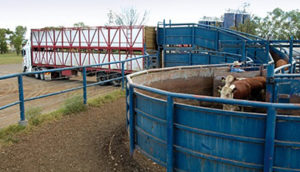Read the latest information on
Foot-and-mouth disease
 Have you considered what you’d do if your livestock were unable to leave your property when you want or need them too? There’s a lot to consider when faced with the possibility of keeping livestock in place indefinitely, especially the availability of feed, water and other supplies. You may end up missing key dates in your calendar, such as shows, sales or sending your livestock to a processor.
Have you considered what you’d do if your livestock were unable to leave your property when you want or need them too? There’s a lot to consider when faced with the possibility of keeping livestock in place indefinitely, especially the availability of feed, water and other supplies. You may end up missing key dates in your calendar, such as shows, sales or sending your livestock to a processor.
Several editions of Farm Biosecurity news throughout the year have explored the parallels between the COVID-19 pandemic and a biosecurity emergency response in our agricultural industries. The current pandemic presents an interesting case study, because the principles which govern infectious disease outbreaks, control measures and eradication are the same regardless of the animal a disease affects.
“When it comes to disease control every second counts, and control measures and restrictions can come into play without much warning,” said Dr Simon Humphrys, Executive Manager Biosecurity and Animal Health Systems at Animal Health Australia.
“When lockdown orders were put in place in Victoria and South Australia in response to COVID-19, understandably it caught the public off guard and prompted a lot of people to think about what impact the restrictions would have on their household.”
“The situation we’ve seen unfold in those states, albeit challenging for those involved, is a great example of a standstill.”
A livestock standstill is one way to limit the spread of an infectious disease in an emergency, by temporarily halting the movement of livestock to different properties. This enables the responders to ‘catch up’ on tracing, investigations and test results, without worrying that potentially infected animals are continuing to move around and spread the disease.
Once a standstill is called by the government agency coordinating the response, you must not move affected livestock from your property or receive them onto your property, until the standstill is lifted. Depending on the area impacted – which may be a property, region, a state or even the whole country – there may be additional rules imposed by your state or territory government, which they will announce at the time of the standstill.
The specific situation and different jurisdictional regulations will determine what to do with livestock already in transit.
“Everyone in the supply chain – including producers, transporters, saleyards, depots and processors – has a responsibility to make the standstill effective,” said Dr Humphrys.
“For our livestock producers out there, I’d urge them to consider what a standstill might mean for their business, especially if it were to occur at the worst possible moment.”
A standstill presents a unique challenge to a livestock business, as it can impact their ability to meet the sensitive timings of their breeding, growing and selling schedules, or put stress on available supplies of feed, water and housing.
This may impact the welfare outcomes of animals, and a loss of productivity and profit for the producer.
“We’ve seen in Australia and around the world how quickly jurisdictions have responded to prevent outbreaks of COVID-19 crossing their borders, and we have certainly seen the same rapid reaction times with our livestock and meat export markets in the past as well,” Dr Humphrys explained.
“We often encourage producers to consider biosecurity and emergency response planning in the context of business continuity. If the worst were to happen, what will you need to do to keep operating as a business?”
“Even though you might not be directly caught up in the outbreak, it’s likely to still have some effect on your ability to do business. By planning for the possibility of a standstill ahead of time you can ensure you’re ready to ride it out and be back to trading when the standstill is over.”
Resources for biosecurity and emergency response management for business continuity can be found on the Farm Biosecurity website.